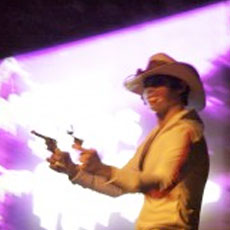This month, we sit down with Quincy Bradford, an undergraduate in the sound department.
Brandon Kosters: So sound art and music. How did you get involved with all of it?
Quincy Bradford: I got started in music, I guess, as a fan. Listening to rock and roll music. Just standard stuff. I was really into bands like Nirvana, noisy kinds of bands. I particularly liked those noisy elements. So long story short, I ended up finding this book that was on avant garde rock and roll, and it listed a lot of people who are common in experimental music like John Cage, and … you know, people like that. And so I started trying to find this kind of music. And I heard it. It was weird, and I liked it. That’s why I tried my best to recreate it as my own.
BK: In terms of making some kind of distinction between noise and more conventional music, or just looking at where they converge and become essentially the same thing, what does that mean to you in terms of your own practice?
QB: Like where experimental and conventional music … ?
BK: Yeah. What gap is there, if any, between the two for you? Or, would you say you’re more about finding where they collapse into each other?
QB: There’s a stylistic difference, compositional difference, different instruments, but essentially, it’s all, you know, just creative re-purposing of sound. I don’t really see a distinction between sound art and music. To me, it’s all the same.
BK: What, then, about visual art and music? What are your thoughts about the interplay of the two? What has that meant in terms of your own practice? Do you produce visual work also?
QB: I try (laughs). I think for me, anyway, the tendency is to try to create some direct parallel between sound and visuals, but that’s hardly ever interesting. I think there’s maybe some metaphorical relationship … you can draw a lesson from one and apply it to the other. But as far as art-like, “I’m going to take a picture of a sound,” I don’t think that works too well, or at least, it didn’t for me.
BK: What are you working with in terms of gear?
QB: Right now I’m pretty much working with whatever the school has. Personally at home, I have a laptop, midi keyboard, guitar, and an audio inbox, a PreSonus firebox. I haven’t really been using it that much. I’ve mainly been working with the stuff here [in the sound studios in MacLean], simply because it’s more convenient. It’s easier to be creative here than to go home and have to contend with bed and food and … comfort.
BK: What are you working with when you’re here in the MacLean studios?
QB: Usually I come and play with the analog synthesizer and the sampler. After taking the analog synth class [taught by Robert Snyder]. I’ve been really mainly messing with the synth because I don’t need to bring in any sampling source. I can just create sounds on the fly.
BK: You work in sound. What other disciplines are you engaged in?
QB: I’ve dabbled in photo. I’ve dabbled in video. I did that mainly to learn how other people think about their work and produce work in other media. But I myself don’t necessarily feel like working with those media.
BK: Who do you like to see locally? Are there groups you go to see regularly?
QB: I really enjoy every time I see Fred Holmes, whoever he happens to be playing with. I really enjoyed seeing the Association for the Advancement of Creative Musicians small ensemble at the jazz fest. I just kind of bounce around. …
BK: How has being at SAIC informed your practice?
QB: For one thing, it’s put me around other people who are making work. Back home it was just me in a closet with microphones, whereas now I’m out of isolation and I get to hear other work being made by students and teachers and visiting artists. I feel that it gives me something else to feed off of, as well as just being in the city where there’s a pretty vibrant experimental music community. Actually being able to go out and see these musicians do what they do adds another dimension to experiencing the music, as opposed to just listening to it online and reading about it.







